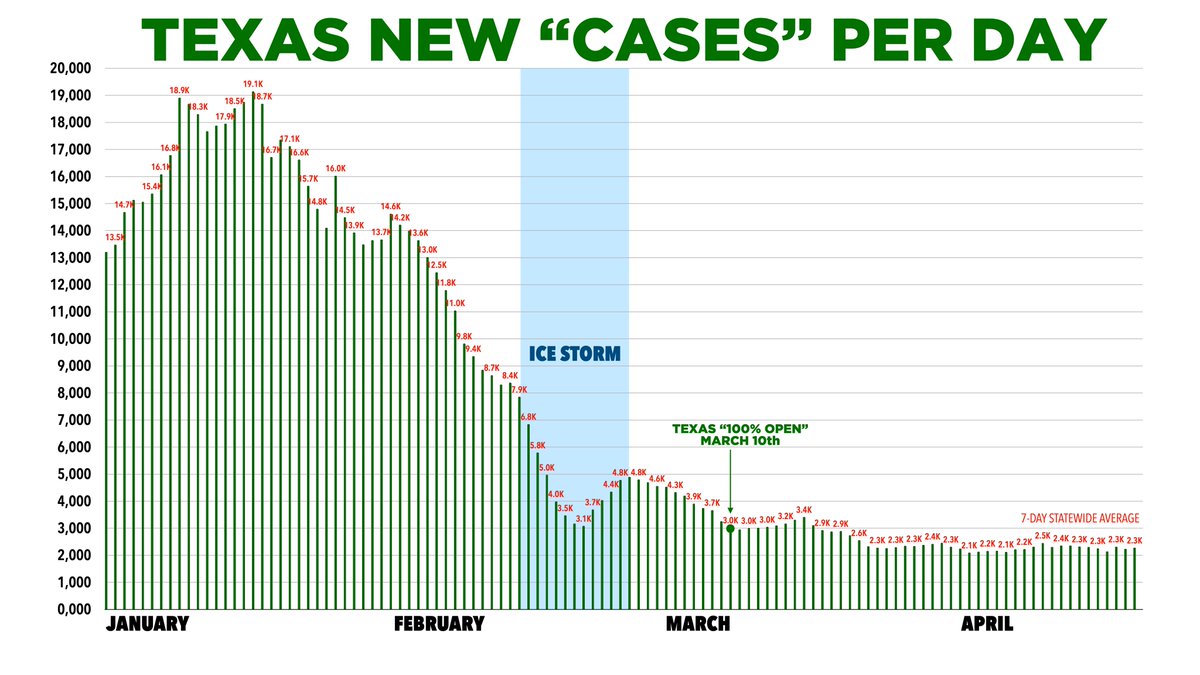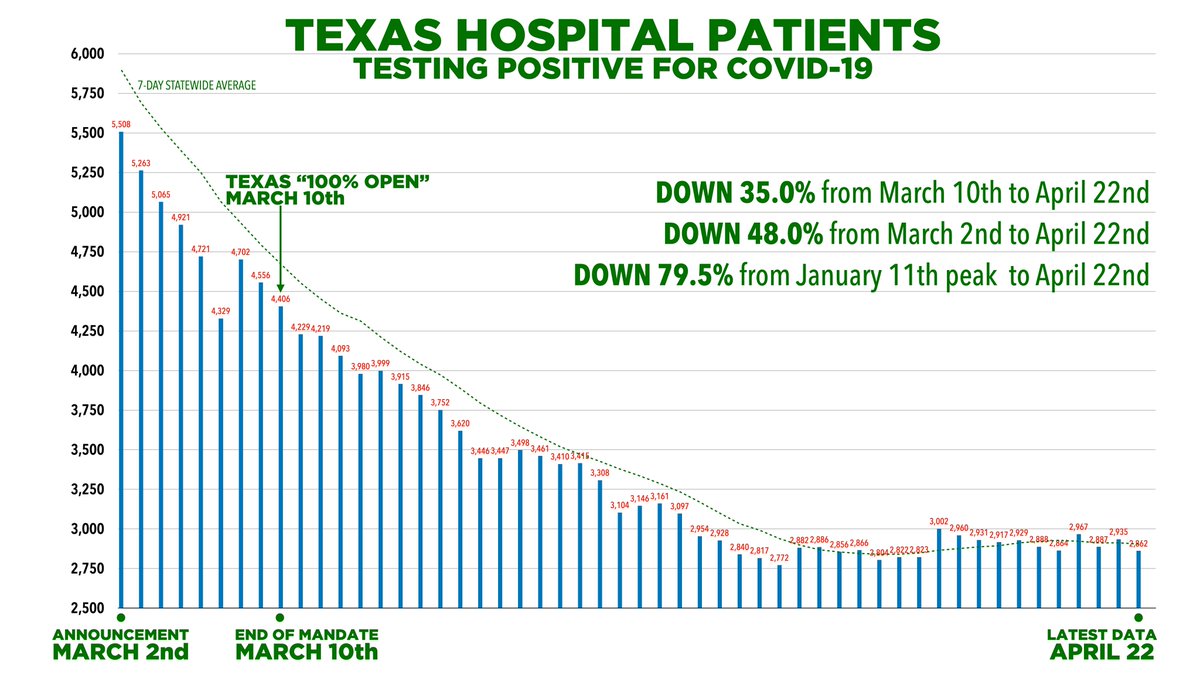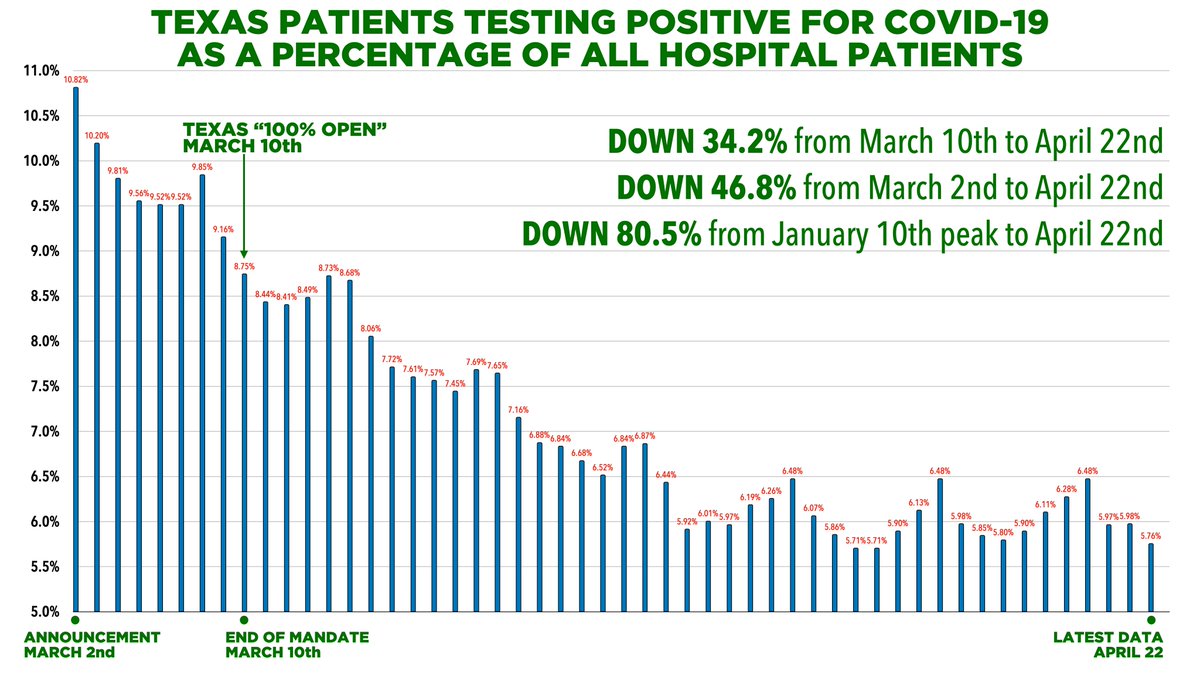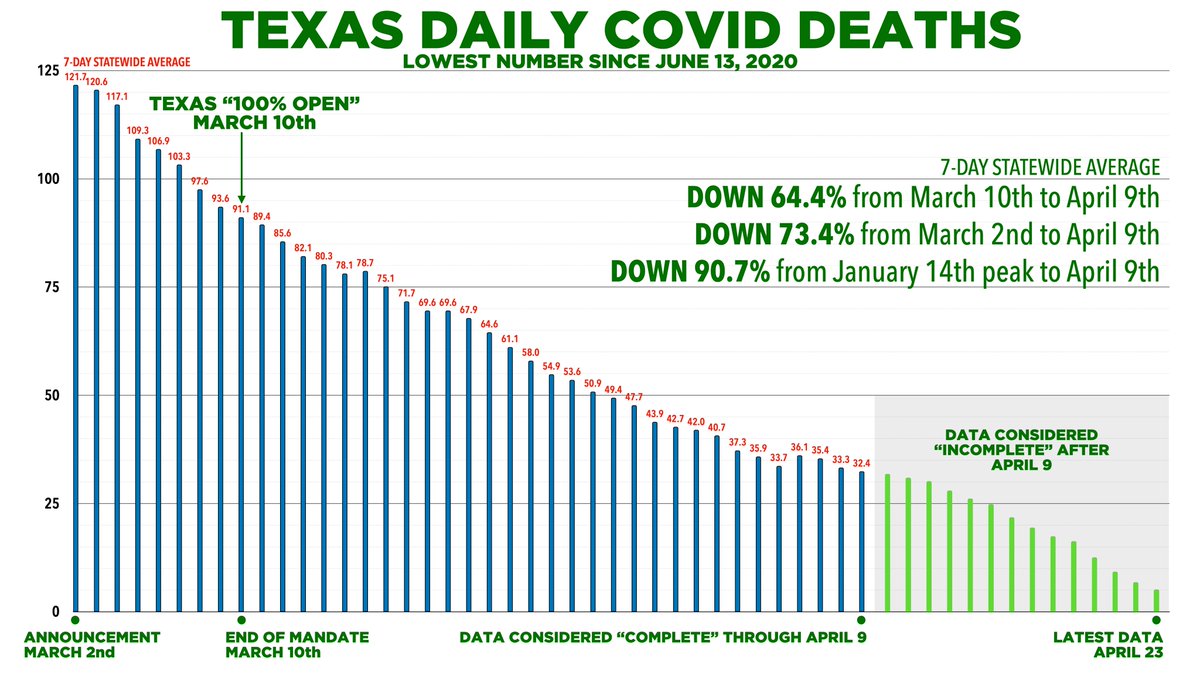It's been another two-and-a-half weeks since we last checked in with the Texas COVID-19 numbers. So how's it going?
https://twitter.com/WILLisms/status/1379137576968327171
It has now been 52 days since @GovAbbott made his announcement that Texas would open on March 10th, "100%," without a statewide mask mandate.
It has been 44 days since Texas reopened 100% with no mask mandates.
The promised apocalypse has apparently been postponed yet again.
It has been 44 days since Texas reopened 100% with no mask mandates.
The promised apocalypse has apparently been postponed yet again.
COVID-19 "cases," hospital patients, ICU patients, and deaths have all fallen in Texas in the 44 days since Texas opened 100% without a statewide mask mandate.
Data from @TexasDSHS: dshs.texas.gov/coronavirus/Ad…



Data from @TexasDSHS: dshs.texas.gov/coronavirus/Ad…




"Cases" of COVID-19 are down in Texas.
✅Down 24.5% since Texas reopened 100% with no statewide mask mandate on March 10th.
✅Down 50% since @GregAbbott_TX made the announcement on March 2nd.
✅Down 88.1% since the peak.
✅Down 24.5% since Texas reopened 100% with no statewide mask mandate on March 10th.
✅Down 50% since @GregAbbott_TX made the announcement on March 2nd.
✅Down 88.1% since the peak.

Zoom out to the beginning of 2021, and you can see that cases are very low relative to the January peak. 

The number of Texans hospitalized and testing positive for COVID-19: down.
✅ Down 35% since Texas reopened 100% with no statewide mask mandate.
✅ Down 48% since @GovAbbott made his announcement.
✅ Down 79.5% since the January 11th peak.
✅ Down 35% since Texas reopened 100% with no statewide mask mandate.
✅ Down 48% since @GovAbbott made his announcement.
✅ Down 79.5% since the January 11th peak.

In terms of available hospital beds, Texas is using about 4.3% for COVID-19 positive patients. This proportion is:
✅ Down 34.2% since Texas reopened 100% with no statewide mask mandate.
✅ Down 47.4% since @GovAbbott's announcement.
✅ Down 79.6% since the January 14 peak.
✅ Down 34.2% since Texas reopened 100% with no statewide mask mandate.
✅ Down 47.4% since @GovAbbott's announcement.
✅ Down 79.6% since the January 14 peak.

Using a 7-day-average, Texas is using 4.5% of available hospital beds for COVID-19 positive patients. This proportion is:
✅ Down 36% since Texas reopened 100% with no statewide mask mandate.
✅ Down 49% since @GovAbbott's announcement.
✅ Down 79.1% since the January 14 peak.
✅ Down 36% since Texas reopened 100% with no statewide mask mandate.
✅ Down 49% since @GovAbbott's announcement.
✅ Down 79.1% since the January 14 peak.

COVID-19 positive patients now comprise 5.76% of hospital patients in Texas. This proportion is:
✅ Down 34.2% since Texas reopened 100% with no statewide mask mandate.
✅ Down 46.8% since @GovAbbott's announcement.
✅ Down 80.5% since the January 10 peak.
✅ Down 34.2% since Texas reopened 100% with no statewide mask mandate.
✅ Down 46.8% since @GovAbbott's announcement.
✅ Down 80.5% since the January 10 peak.

In the 7-day-average, COVID-19 positive patients comprise 6.07% of hospital patients in Texas. This proportion is:
✅ Down 35.8% since Texas reopened 100% with no statewide mask mandate.
✅ Down 47.8% since @GregAbbott_TX's announcement.
✅ Down 78.3% since the January 14 peak.
✅ Down 35.8% since Texas reopened 100% with no statewide mask mandate.
✅ Down 47.8% since @GregAbbott_TX's announcement.
✅ Down 78.3% since the January 14 peak.

Today, we had the lowest number Texas ICU patients, going back to June 13th, 2020.
✅ Down 37.6% since Texas reopened 100% with no statewide mask mandate.
✅ Down 50.2% since @GregAbbott_TX's announcement.
✅ Down 76.9% since the January 19th peak.
✅ Down 37.6% since Texas reopened 100% with no statewide mask mandate.
✅ Down 50.2% since @GregAbbott_TX's announcement.
✅ Down 76.9% since the January 19th peak.

In the 7-day statewide average, we had the lowest number of Texas ICU patients, going back to June 13th, 2020.
✅ Down 379% since Texas reopened 100% with no statewide mask mandate.
✅ Down 51.5% since the announcement by @GovAbbott.
✅ Down 76% since the January 19th peak.
✅ Down 379% since Texas reopened 100% with no statewide mask mandate.
✅ Down 51.5% since the announcement by @GovAbbott.
✅ Down 76% since the January 19th peak.

Enough time has now elapsed that we can examine deaths after Texas reopened 100% with no statewide mask mandate.
Deaths with COVID-19 in Texas are:
✅ Down 66% from March 10 to April 9.
✅ Down 67% from March 2 to April 9.
✅ Down 91.5% from January 13 peak to April 9.
Deaths with COVID-19 in Texas are:
✅ Down 66% from March 10 to April 9.
✅ Down 67% from March 2 to April 9.
✅ Down 91.5% from January 13 peak to April 9.

Using the 7-day statewide average and ending on April 9th (after that, data = incomplete), daily deaths with COVID-19 in Texas are:
✅ Down 64.4% from the date Texas reopened 100% with no statewide mask mandate.
✅ Down 73.4% from March 2.
✅ Down 90.7% from January 14 peak.
✅ Down 64.4% from the date Texas reopened 100% with no statewide mask mandate.
✅ Down 73.4% from March 2.
✅ Down 90.7% from January 14 peak.

Since Texas reopened 100% with no statewide mask mandate 44 days ago, and since @GregAbbott_TX announced the decision 52 days ago, all the relevant numbers have improved.
• • •
Missing some Tweet in this thread? You can try to
force a refresh













